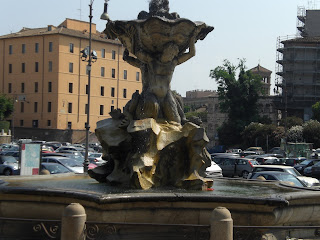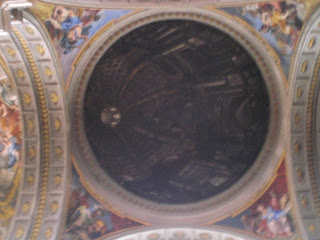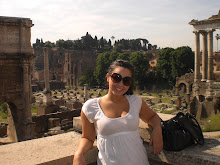Sunday, May 31, 2009
The Race is On
Hot Lunch Jam
Next in Line
Lining the streets of Pincio Gardens are various busts of remarkable people from Rome’s history including artists, heroes, and a few philosophers. Before coming to Rome I had no idea what a “bust” was. It is a portrait or sculpture of a person showing only the head and shoulders. There are a total of 228 white marble busts in all. Unfortunately, some are falling apart or display some graffiti but most of that can be ignored.
*Added information taken from DK Eyewitness Guide to Rome and http://www.aviewoncities.com/rome/pinciogardens.htm
Friday, May 29, 2009
Romance and the Dead
Thursday, May 28, 2009
Walk This Way
Barca, Barca, Barca!
Barcelona fans crowding the Trevi Fountain Tuesday night.
Tuesday, May 26, 2009
Walking Through the Ruins
*Added information from DK Eyewitness Guide to Rome
Salad Days are Here Again
Monday, May 25, 2009
Someone to Save You

Sunday, May 24, 2009
On the Coast of Somewhere Beautiful
Friday, May 22, 2009
Life Can Be Sweet

*Added information is from WhyGelato.com - A Gelato-Inspired Resource. 20 May 2009
Hickory Dickory Dock

Thursday, May 21, 2009
Story of an Artist

Raffaelo Sanzio, although he is more commonly known by just his first name, was one of the great artists of the Renaissance era along with Leonardo DaVinci and Michelangelo. He studied in Perusia under Perugino for four years. In his early works his style reflected his educated at the Perugino School but in his later works, he developed his own style which was influenced greatly by both Leonardo and Michelangelo. His most famous works include The School of Athens, which is currently displayed in the Vatican Museum, The Triumph of Galatea, and Sistine Madonna. The work that established Raphael as a prominent artist in Rome was his work in the Vatican. Pope Julius II asked Raphael to redecorate the four rooms of his private apartments. So Raphael and his students began the work in 1508 but Raphael died before it was all completed. The frescoes show the religious and philosophical ideals of the Renaissance. The four rooms are the Hall of Constantine, the Room of Heliodorus, the Room of the Segnatura, and the Room of The Fire in the Borgo. Raphael's contribution to the High Renaissance was his ability to not only depict the scene of an event but to decipher the subject.
The Dispute over the Holy Sacrament from Room of the Segnatura
*Additional Information taken from "Raphael." Mark Harden's Artchive. 21 May 2009 http://www.artchive.com/artchive/R/raphael.html. and Publishing, DK. Rome (Eyewitness Travel Guides). New York: DK Travel, 2003.*Images taken from nicholas.learnerblogs.org/.../13/raphael-sanzio/ and http://flickr.com/photos/37409770@N00/2103929036
The View From the Top
After we visited the Basilica, we tried to visit the Vatican Museum but it was closed because today was Ascension Thursday- the 40th day after Easter Sunday, marking Jesus's ascension into Heaven. So instead, we climbed the many stairs to the top of the St. Peter's dome.
Half way up, you could look down into the basilica and we got to oversee the ongoing mass in celebration of the holy say. The stairs were a little bit scary, very cramped, and a little smelly, but the view at the top was worth the climb. You could see the entire Piazza San Pietro, the Vatican gardens, and most of the city. It was absolutely amazing.
Wednesday, May 20, 2009
This Little Piggy Went to Market
Tuesday, May 19, 2009
5 O'Clock at the Oasis
Get Me to the Church on Time
The thing that surprised me the most was the "dome". Right in the middle of the church, it looks like there is a huge dome, as was the original plan for the church. But the dome was never built and the area was filled in, but it was painted to give you the illusion of a dome! It was pretty incredible to see because if my professor wouldn't of told me that, I never would of known. It is a pretty well-known tourist site, I think due mainly to the amazing artwork and the unusual, optical illusion "dome".
The Pantheon
The inscription on the front of the Pantheon still reads the original Latin inscription...
"M. AGRIPPA.L.F.COSTERTIUM.FECIT” which means “Marcus Agrippa son of Lucius, having been consul three times made it”. How cool is that to have your name inscribed on a building that has lasted for centuries! Emperor Hadrian built this Pantheon to replace Marcus Agrippa's Pantheon that burned to the ground.
Of course the most striking thing about the Pantheon is the incredible architecture. The sheer enormity of the inside is crazy. The marble floor is beautiful and the granite pillars outside are wider than a person and 10 times as tall. Being inside the Pantheon, looking up at the oculus, makes you feel incredibly small.
*Added information from "Rome.info Roman Pantheon." Rome.info Rome tourist information, Ancient Rome travel guide. 19 May 2009 http://www.rome.info/pantheon/.
Sunday, May 17, 2009
Garden of Delights

Saturday, May 16, 2009
Scenes From an Italian Restaurant
 For my class, we have to pick an ongoing theme for our blogs. Since Italy is an area of such lavish cuisine, I have chosen food for my theme. So far, I have loved everything I have eaten. And coming from a usually picky eater, that is saying something. In Italy you can get food from a multitude of places like a ristorante, a trattoria, an enoteca, or a birrerie to name a few, all of which are scattered throughout the city. A ristorante is a more elegant place to eat and is therefore more expensive. A trattoria is more of a family-run business and offers excellent home cooking. An enoteca offers snacks, rather than full course meals, and many times include well-stock wine shops. A birrerie is better for an informal, sit-down lunch or dinner. One thing I love about Italian restaurants is the outdoor seating. Most restaurants have their tables outside and you can enjoy your food and the excellent weather, as well as the sights!
For my class, we have to pick an ongoing theme for our blogs. Since Italy is an area of such lavish cuisine, I have chosen food for my theme. So far, I have loved everything I have eaten. And coming from a usually picky eater, that is saying something. In Italy you can get food from a multitude of places like a ristorante, a trattoria, an enoteca, or a birrerie to name a few, all of which are scattered throughout the city. A ristorante is a more elegant place to eat and is therefore more expensive. A trattoria is more of a family-run business and offers excellent home cooking. An enoteca offers snacks, rather than full course meals, and many times include well-stock wine shops. A birrerie is better for an informal, sit-down lunch or dinner. One thing I love about Italian restaurants is the outdoor seating. Most restaurants have their tables outside and you can enjoy your food and the excellent weather, as well as the sights! 








































